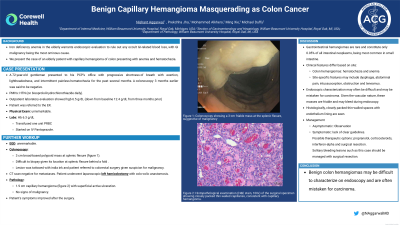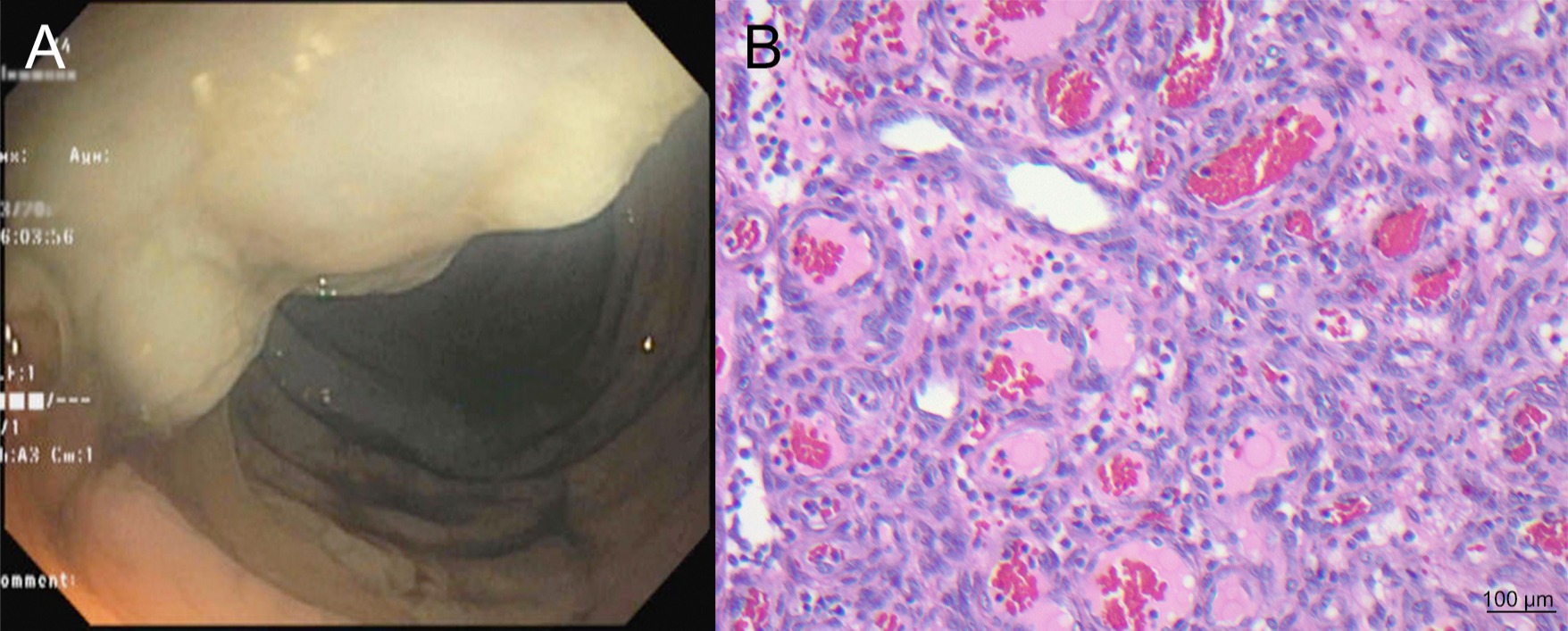Tuesday Poster Session
Category: Colon
P3095 - Benign Capillary Hemangioma Masquerading as Colon Cancer
Tuesday, October 24, 2023
10:30 AM - 4:00 PM PT
Location: Exhibit Hall

Has Audio
.jpg)
Nishant Aggarwal, MD
William Beaumont Hospital-Royal Oak
Royal Oak, MI
Presenting Author(s)
Nishant Aggarwal, MD1, Prekchha Jha, MBBS2, Mohammed Alkhero, MD1, Ming Xie, MD1, Michael Duffy, MD1
1William Beaumont Hospital-Royal Oak, Royal Oak, MI; 2Corewell Health, Royal Oak, MI
Introduction: Iron deficiency anemia in the elderly warrants endoscopic evaluation to rule out any occult GI-related blood loss, with GI malignancy being the most ominous cause. We present the case of an elderly patient with capillary hemangioma of colon presenting with anemia and hematochezia.
Case Description/Methods: A 72-year-old gentleman presented to his doctor’s office with progressive shortness of breath, lightheadedness, and intermittent painless hematochezia for the past few months. A colonoscopy 3 months earlier was said to be negative. He had a history of hypertension for which he took bisoprolol-hydrochlorothiazide daily. Outpatient labs showed Hgb 6.5 g/dL (down from baseline 12.4 g/dL from 3 months ago). He was admitted, transfused with one unit of PRBC with hgb improvement to 7 g/d and started on intravenous pantoprazole 40 mg twice daily. An EGD was unremarkable. Colonoscopy showed a 3 cm polypoid broad-based mass at splenic flexure (Fig 1A), suspicious for malignancy. The mass was very difficult to biopsy given its location at the splenic flexure behind a fold. The lesion was tattooed with India ink. Given the suspicion of malignancy based on the gross appearance, the patient was referred to colorectal surgery. A CT scan was negative for any metastases. He underwent a laparoscopic left hemicolectomy with colo-colic anastomosis. The pathology confirmed a 1.9 cm capillary hemangioma with superficial active ulceration, and no signs of tissue invasion or malignancy (fig 1B). Thereafter, the patient’s symptoms improved.
Discussion: Gastrointestinal hemangiomas are rare and constitute only 0.05% of all intestinal neoplasms, being most common in small intestine. Clinically, patients with colon hemangiomas can present with large volume hematochezia and symptomatic iron-deficiency anemia. Additionally, site-specific features may include dysphagia, abdominal pain, intussusception, obstruction and tenesmus. Endoscopic characterization may often be difficult and may be mistaken for carcinoma. Given the vascular nature, these masses are friable and may bleed during endoscopy. Histologically, closely packed thin-walled spaces with endothelium lining are seen. While asymptomatic cases can be managed by close observation, there is a lack of clear guidelines on management of symptomatic colon hemangiomas. Possible therapeutic options include propranolol, corticosteroids, interferon-alpha, and surgical resection. Solitary bleeding lesions such as this case should be managed with surgical resection.

Disclosures:
Nishant Aggarwal, MD1, Prekchha Jha, MBBS2, Mohammed Alkhero, MD1, Ming Xie, MD1, Michael Duffy, MD1. P3095 - Benign Capillary Hemangioma Masquerading as Colon Cancer, ACG 2023 Annual Scientific Meeting Abstracts. Vancouver, BC, Canada: American College of Gastroenterology.
1William Beaumont Hospital-Royal Oak, Royal Oak, MI; 2Corewell Health, Royal Oak, MI
Introduction: Iron deficiency anemia in the elderly warrants endoscopic evaluation to rule out any occult GI-related blood loss, with GI malignancy being the most ominous cause. We present the case of an elderly patient with capillary hemangioma of colon presenting with anemia and hematochezia.
Case Description/Methods: A 72-year-old gentleman presented to his doctor’s office with progressive shortness of breath, lightheadedness, and intermittent painless hematochezia for the past few months. A colonoscopy 3 months earlier was said to be negative. He had a history of hypertension for which he took bisoprolol-hydrochlorothiazide daily. Outpatient labs showed Hgb 6.5 g/dL (down from baseline 12.4 g/dL from 3 months ago). He was admitted, transfused with one unit of PRBC with hgb improvement to 7 g/d and started on intravenous pantoprazole 40 mg twice daily. An EGD was unremarkable. Colonoscopy showed a 3 cm polypoid broad-based mass at splenic flexure (Fig 1A), suspicious for malignancy. The mass was very difficult to biopsy given its location at the splenic flexure behind a fold. The lesion was tattooed with India ink. Given the suspicion of malignancy based on the gross appearance, the patient was referred to colorectal surgery. A CT scan was negative for any metastases. He underwent a laparoscopic left hemicolectomy with colo-colic anastomosis. The pathology confirmed a 1.9 cm capillary hemangioma with superficial active ulceration, and no signs of tissue invasion or malignancy (fig 1B). Thereafter, the patient’s symptoms improved.
Discussion: Gastrointestinal hemangiomas are rare and constitute only 0.05% of all intestinal neoplasms, being most common in small intestine. Clinically, patients with colon hemangiomas can present with large volume hematochezia and symptomatic iron-deficiency anemia. Additionally, site-specific features may include dysphagia, abdominal pain, intussusception, obstruction and tenesmus. Endoscopic characterization may often be difficult and may be mistaken for carcinoma. Given the vascular nature, these masses are friable and may bleed during endoscopy. Histologically, closely packed thin-walled spaces with endothelium lining are seen. While asymptomatic cases can be managed by close observation, there is a lack of clear guidelines on management of symptomatic colon hemangiomas. Possible therapeutic options include propranolol, corticosteroids, interferon-alpha, and surgical resection. Solitary bleeding lesions such as this case should be managed with surgical resection.

Figure: Figure 1: (A) Colonoscopy showing a 3-cm friable mass at the splenic flexure, suggestive of malignancy, and (B) Histopathological examination (H&E stain, 100x) of the surgical specimen showing closely packed thin-walled capillaries, consistent with a capillary hemangioma.
Disclosures:
Nishant Aggarwal indicated no relevant financial relationships.
Prekchha Jha indicated no relevant financial relationships.
Mohammed Alkhero indicated no relevant financial relationships.
Ming Xie indicated no relevant financial relationships.
Michael Duffy indicated no relevant financial relationships.
Nishant Aggarwal, MD1, Prekchha Jha, MBBS2, Mohammed Alkhero, MD1, Ming Xie, MD1, Michael Duffy, MD1. P3095 - Benign Capillary Hemangioma Masquerading as Colon Cancer, ACG 2023 Annual Scientific Meeting Abstracts. Vancouver, BC, Canada: American College of Gastroenterology.
